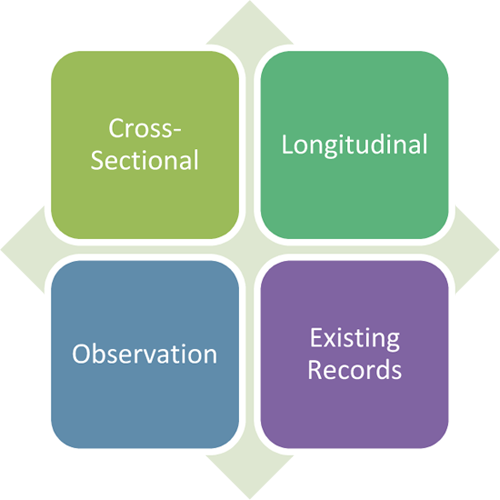Module 2: Research Design - Section 1
Section 1: Descriptive Studies
Definition: A descriptive study is one in which information is collected without changing the environment (i.e., nothing is manipulated).
A descriptive study is one in which information is collected without changing the environment (i.e., nothing is manipulated). Sometimes these are referred to as " correlational " or " observational " studies. The Office of Human Research Protections (OHRP) defines a descriptive study as "Any study that is not truly experimental." In human research, a descriptive study can provide information about the naturally occurring health status, behavior, attitudes or other characteristics of a particular group. Descriptive studies are also conducted to demonstrate associations or relationships between things in the world around you.
Descriptive studies can involve a one-time interaction with groups of people (cross-sectional study),

or a study might follow individuals over time (longitudinal study).


 Descriptive studies, in which the researcher interacts with the participant, may involve surveys or interviews to collect the necessary information.
Descriptive studies, in which the researcher interacts with the participant, may involve surveys or interviews to collect the necessary information.
Descriptive studies in which the researcher does not interact with the participant include observational studies of people in an environment (e.g., "fly on the wall") and studies involving data collection using existing records (e.g., medical record review).
Case Example For A Descriptive Study
 A researcher wants to know why individuals in Community A have a higher rate of a rare form of cancer when compared to those living in Community B. To find out the reasons for the differences in cancer rates in these two communities, the investigator surveyed residents about their lifestyle, noted the types of businesses that were present in the community and searched medical records. The researcher found that the headquarters for the Toxico Chemical Plant is located in Community A, there is a higher rate of cigarette smoking in this community and residents tended to delay or skip going to the doctor for an annual checkup. In Community B, the largest employer was a department store and on average, residents did not smoke as much as residents from Community A. However, like individuals from Community A, Community B residents tended to delay or skip their annual checkup with their doctor.
A researcher wants to know why individuals in Community A have a higher rate of a rare form of cancer when compared to those living in Community B. To find out the reasons for the differences in cancer rates in these two communities, the investigator surveyed residents about their lifestyle, noted the types of businesses that were present in the community and searched medical records. The researcher found that the headquarters for the Toxico Chemical Plant is located in Community A, there is a higher rate of cigarette smoking in this community and residents tended to delay or skip going to the doctor for an annual checkup. In Community B, the largest employer was a department store and on average, residents did not smoke as much as residents from Community A. However, like individuals from Community A, Community B residents tended to delay or skip their annual checkup with their doctor.






